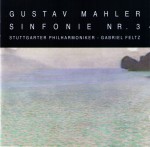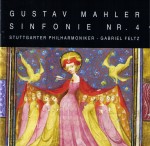 Is there too much Mahler being performed these days? The venerable Dutch conductor Bernard Haitink believes so, contending that a “Mahler cult” has created a glut on the market which is distorting orchestral programming in favour of this formerly maligned composer and threatening to marginalize even the mighty Beethoven. There are even those, he claims, who never set foot in a concert hall unless Mahler is programmed. Hopefully, he concludes, Mahler mania will fade away in due time (like the collapse of the Dutch tulip mania of 1637 perchance?). It is a peculiar assertion coming from a man who has recorded the entire cycle of symphonies twice over and continues to churn out new performances with a global selection of orchestras; even so, Mahler himself predicted his symphonies would someday surpass Beethoven’s in popularity. Any conductor or ensemble worth their salt these days feels duty-bound to tackle them, regardless of their capability for or empathy with the complex and demanding works. It helps too that Mahler’s own conducting experience led him to virtually “idiot-proof” his scores with extremely detailed performance instructions throughout, and his obsessive retouching of his instrumentation after every performance has resulted in new editions continuing to appear to this day. Especially in the recent double centenary years this has led to many high-profile integral cycles springing forth bearing a uniform, streamlined quality all too often indistinguishable from each other.
Is there too much Mahler being performed these days? The venerable Dutch conductor Bernard Haitink believes so, contending that a “Mahler cult” has created a glut on the market which is distorting orchestral programming in favour of this formerly maligned composer and threatening to marginalize even the mighty Beethoven. There are even those, he claims, who never set foot in a concert hall unless Mahler is programmed. Hopefully, he concludes, Mahler mania will fade away in due time (like the collapse of the Dutch tulip mania of 1637 perchance?). It is a peculiar assertion coming from a man who has recorded the entire cycle of symphonies twice over and continues to churn out new performances with a global selection of orchestras; even so, Mahler himself predicted his symphonies would someday surpass Beethoven’s in popularity. Any conductor or ensemble worth their salt these days feels duty-bound to tackle them, regardless of their capability for or empathy with the complex and demanding works. It helps too that Mahler’s own conducting experience led him to virtually “idiot-proof” his scores with extremely detailed performance instructions throughout, and his obsessive retouching of his instrumentation after every performance has resulted in new editions continuing to appear to this day. Especially in the recent double centenary years this has led to many high-profile integral cycles springing forth bearing a uniform, streamlined quality all too often indistinguishable from each other.
 It is therefore refreshing to come across these very interesting and idiosyncratic performances from the Stuttgart Philharmonic, which began appearing without much fanfare once a year on the Dreyer Gaido label soon after the young (born 1971) Gabriel Feltz was appointed director of the Stuttgart ensemble in 2004. Feltz has yet to make his conducting debut on this continent and this orchestra’s recordings have only recently been added to the Naxos catalogue. A remarkable feature of these discs is the conductor’s own insightful program notes, replete with music examples (!) and cogent arguments for Feltz’s interpretations, which often contradict or re-interpret the printed scores. The most daring example is undoubtedly the startling up-tempo interpretation of the rabble-rousing march midway through the first movement of the
It is therefore refreshing to come across these very interesting and idiosyncratic performances from the Stuttgart Philharmonic, which began appearing without much fanfare once a year on the Dreyer Gaido label soon after the young (born 1971) Gabriel Feltz was appointed director of the Stuttgart ensemble in 2004. Feltz has yet to make his conducting debut on this continent and this orchestra’s recordings have only recently been added to the Naxos catalogue. A remarkable feature of these discs is the conductor’s own insightful program notes, replete with music examples (!) and cogent arguments for Feltz’s interpretations, which often contradict or re-interpret the printed scores. The most daring example is undoubtedly the startling up-tempo interpretation of the rabble-rousing march midway through the first movement of the  Third Symphony (CD 21065), utterly contradicting Mahler’s call for a steady tempo throughout this section. Other examples are less radical yet still telling: the compulsive alternations of nimbleness and near panic of the
Third Symphony (CD 21065), utterly contradicting Mahler’s call for a steady tempo throughout this section. Other examples are less radical yet still telling: the compulsive alternations of nimbleness and near panic of the
Fourth Symphony’s (CD 21072) ostensively charming opening movement; the utter serenity Feltz brings to the famous Adagietto of the Fifth Symphony (CD 21052), so often bathed in an excess of sentimentality; or the positively erotic atmosphere he conjures towards the end of the second “Nachtmusik” of the Seventh Symphony (CD 21041).
 I especially enjoyed reading his statistical argument for the placing of the Scherzo as the second movement of the Sixth Symphony (CD 21045), settling once and for all a specious argument that has gone on for decades amongst musicologists. His interpretation of the first movement of the Sixth is notable for its urgently martial clip, offset by a luxuriant pulling back of the tempo for the secondary theme in just the right proportion. Feltz’s solution to the potpourri finale of the Seventh at first seems counterintuitive; he emphasizes the disjointedness of the rondo form rather than smoothing it over, yet it somehow works quite successfully.
I especially enjoyed reading his statistical argument for the placing of the Scherzo as the second movement of the Sixth Symphony (CD 21045), settling once and for all a specious argument that has gone on for decades amongst musicologists. His interpretation of the first movement of the Sixth is notable for its urgently martial clip, offset by a luxuriant pulling back of the tempo for the secondary theme in just the right proportion. Feltz’s solution to the potpourri finale of the Seventh at first seems counterintuitive; he emphasizes the disjointedness of the rondo form rather than smoothing it over, yet it somehow works quite successfully.
 Of all these performances perhaps the massive Third Symphony takes pride of place for the excellent unnamed trombone soloist in the first movement, the unmannered gracefulness of the middle movements and the very moving alto solo (Alexandra Petersamer) in the penultimate movement; only the finale seems to fall a bit short in sonic intensity. Perhaps the orchestra was a bit tuckered by this point however; these are all live performances including ofttimes thunderous applause at their conclusions from the otherwise respectfully taciturn audience.
Of all these performances perhaps the massive Third Symphony takes pride of place for the excellent unnamed trombone soloist in the first movement, the unmannered gracefulness of the middle movements and the very moving alto solo (Alexandra Petersamer) in the penultimate movement; only the finale seems to fall a bit short in sonic intensity. Perhaps the orchestra was a bit tuckered by this point however; these are all live performances including ofttimes thunderous applause at their conclusions from the otherwise respectfully taciturn audience.
The sound is clear and spacious, with no evident sonic trickery, though I did find the volume needed to be cranked a bit higher than normal to bring the string section into focus. Though there are unquestionably finer isolated performances of these works to be found in the ever-growing Mahler discography, very few contemporary cycles exhibit the integrity of vision Feltz brings to these works. I look forward to enjoying the remaining five symphonies in this cycle in the years to come; there’s never enough Mahler for me!



